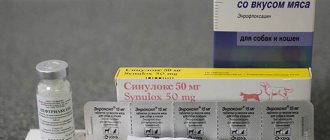One of the symbols of home comfort, a calm and measured life nowadays is the domestic cat. Most often, the behavior of this animal is presented as lazy spending time on the couch and complete peace. But this is a common misconception. Cats, like people, can experience severe stress, especially in situations that are unusual for them.
A nervous, excited state can cause health problems in your pet, both physical and mental. Therefore, it is so important for the owner not only to have a sedative for cats on hand, but also to be able to choose and use it correctly so as not to harm the animal.
When you might need a sedative
global $ads_google;
//data-ad-slot=”2475549904″ $ads_google = empty($ads_google) ? false : true; ?> if ($ads_google == false) {?> $ads_google = true; ?> } ?> A sedative should not be used without good reason. If there is a chance to calm the cat in another way, it is better not to resort to drug intervention, even one based on a phytotherapeutic effect. The stress that the cat experiences from the arrival of guests could be neutralized by purchasing a soft house, in the niche of which the animal will feel protected. You can make such a house with your own hands.
In the cases described below, you may actually need the help of sedatives.
Mental disorders
Outwardly, such violations manifest themselves in endless licking of the fur, which can even lead to its thinning. The skin under the fur looks irritated from constant contact with saliva and tongue. In addition, the cat may hunt for a non-existent target, twitch and jump for no reason, and constantly meow unmotivated.
Transporting a pet
During transportation, especially when the cat is not accustomed to this from early childhood, the animal may become stressed. If in a car the problem comes down only to a new way of moving, then public transport can easily cause panic in the cat. You will have to focus on your pet; there are also those who are just happy to go for a ride.
If the standard behavior changes, it will have to be corrected with medication. When planning a move, it is better to give your pet medicine in advance, especially if the instructions for the sedative drug say that it has a cumulative effect. It is better to learn in advance how to properly transport cats in a carrier.
Stress
Stress occurs for a number of reasons, including part of mental disorders and the circumstances of the pet’s living conditions. In many cases, it is better to consult a specialist and find the cause of the stressful condition. Probably, if you eliminate it, you won’t need to take medications.
Grooming
Grooming is highly valued by owners, but animals are not always as happy as visiting exhibitions. If large-scale procedures are planned, you can treat the cat with sedatives.
Castration
Castration and sterilization, as a surgical intervention in the body, also cause the cat to experience serious stress, both on the physical and mental level.
global $ads_google; //data-ad-slot=”2475549904″ $ads_google = empty($ads_google) ? false : true; ?> if ($ads_google == false) {?>
$ads_google = true; ?> } ?>
Aggression
Fear, anxiety, and phobia can result in aggressive behavior. Aggression that is not typical behavior must be corrected.
Estrus
Against the background of estrus, aggression and hypersexuality may also occur, which can be very difficult to tolerate. Activation of the sexual instinct affects the well-being of pets, sometimes causing them to actually suffer.
Cat behavior
Many reactions of cats are normal and characteristic of them as a species. Various forms of aggression, anxiety states, “attacks” of rabies - all this would be the norm if a cat lived outside of a human home and family.
Something else interesting: How to choose and use anti-festival drops for cats
Prerequisites for behavioral disorders
Modern research shows that most complaints about “inappropriate” behavior in pets are associated with purebred animals. Experts suggest: this is due to the fact that it is the pedigree cats that have to spend their lives in a confined space without the opportunity to realize the wild energy, the species’ genetic essence.
No matter how pure the breed, the instincts of a hunter, owner of the territory, parent and independent personality remain at the DNA level. If someone encroaches on the cat’s sacred sites, the cat actively defends itself. Such defense can take different forms:
- Anxious behavior (meowing, scratching, mobility, marking territory, licking, self-harm, etc.);
- Disturbances in sleep and wakefulness;
- Aggression (biting, scratching, attack or defense);
- Apathy, deep depression.
The reasons may be different, but more often they lie in the imbalance between the lives of people and the natural needs of the cat. For example, howling and physical activity during estrus is absolutely normal for a female. Night jumps around the house are also natural for a hunter. And even strange behavior during stress is quite consistent with the natural norm.
Would a cat agree to become a pet if she knew that she was being kept to be cuddled or as a toy for children? Does a cat want to be deprived of claws or teeth, surgically cut off all paths to reproduction?
Build harmonious relationships
A properly raised cat does not suffer from the limitations of its natural instincts, as it is compensated through play, socialization, exploration and physical activity. But here are the main mistakes that lead to the fact that cute kittens grow into clawed and toothy domestic tyrants:
- Undersocialization. The lack of information about the world around us causes a natural reaction to appear - fear. Not without human effort, fear can turn into a phobia. And here escapes, aggression, and depression arise;
- An impoverished experience. An animal raised under a glass bell is defenseless against any external changes. Any stress immediately acquires destructive force;
- Obsessive caresses. Animals have the right to personal space, personal time, preservation of the smell of their fur, etc.;
- Bad games. What does the owner teach the cat when he throws it behind his back and, using his hand to depict a huge mouth, trembles the pet’s belly? When correcting aggression, you need to say stop to any aggressive games;
- Punishments. They punish most often for something that has not yet been explained, or for something that is the norm of physiology. The consequence is a defensive reaction of the body and psyche, distortion of behavior;
- Lack of load. This refers to physical and intellectual stress. If sensory experience is impoverished, the animal suffers from an excess of unrealized psychic energy. How the cat will “let off steam” next time is anyone’s guess.
An animal will not eat, drink, sleep, go to the toilet, much less play and reproduce, until the basic, basic need is met - for safety. The instinct of self-preservation causes cats to show anxiety, aggression and depression.
Special medications will help neutralize chemical reactions in the cat’s brain and temporarily create a stop reaction, but harmonizing the relationship between the cat and its family will make behavioral therapy truly effective. Owners need to transform their own behavior and change a lot in the environment to help their pet get rid of a psychological or mental problem.
Types of sedatives
Cat sedatives are divided into several types:
- homeopathic;
- chemical;
- hormonal;
- tranquilizers.
Homeopathic medicine is represented by preparations of plant or animal origin. This is an alternative to medicine that uses low concentrations of potent substances.
From the use of chemicals, the effect occurs quickly and noticeably.
When taking hormonal drugs, a positive effect also occurs during periods of sexual overstimulation.
Tranquilizers are used in rare cases when sound sleep is necessary during long trips, or for diagnostics in a veterinary hospital. These medications will be prescribed by your veterinarian.
Any of a number of sedatives will act on the entire nervous system, relaxing the cat, normalizing blood pressure and breathing, and removing fear.
Chemicals
Now let's look at how chemicals work.
Xylazine
Fast-acting antipsychotic. Usually the effect is noticeable after 5 minutes. Available in the form of ampoules for injection. It has many contraindications and is rarely used at home. Depending on the dose, it can quickly calm the animal or anesthetize it before surgery.
Amitriptyline
This sedative drug is considered a good antidepressant. Helps with chronic restlessness and constant meowing. Suitable for cats who mark things. It can act as a sleeping pill, so it is often given at night. If used frequently, it may contribute to weight gain.
Buspirone
The drug is prescribed for phobias and panic attacks in cats. The effect appears only a month after the start of treatment. Release form: tablets.
Vetranquil
Fast-acting antipsychotic, release form - injection ampoules. Can only be used by a veterinarian or experienced breeders with his consent. Helps well against motion sickness. In large doses it is also used for operations.
Diazepam
Strong tranquilizer. It is used to combat nervousness, aggression, excessive excitability, and fears. Suitable as a preventive measure during transportation. Available only by prescription.
Such drugs are selected individually for each pet. The veterinarian prescribes the dosage and duration of use. It should be noted that using them for a long time can be addictive. In addition, they should be used in very difficult situations, as well as when homeopathy has not brought results.
Chemicals begin to act immediately. For kittens, the use of synthetic products is excluded in order to avoid disruption of the systems of the growing body.
Amitriptyline
The drug is intended for intramuscular and intravenous administration. It has a strong calming effect in cases of serious nervous disorders, uncontrolled aggression and increased anxiety.
Xylazine
A potent sedative drug intended for injection. Effective instantly. A frightened and aggressive cat immediately calms down. The medicine has a wide range of contraindications.
Vetranquil
This medicine is available in the form of a liquid for injections, its effect begins within 5 minutes. It not only has a sedative effect, but also copes well with the problem of motion sickness.
Dizepam
The drug is a strong tranquilizer and is used to eliminate aggression, excessive excitability and nervous breakdown.
Buspirone
The drug is available in tablet form and is an excellent antidepressant. Prescribed to animals for panic, mania and phobias. After use, tension is relieved, calm comes, but the long-term effect is visible after use for a month.
When is it better not to give sedatives?
Each drug may have its own contraindications, which can be found in the instructions. But there are also general conditions that prohibit the use of sedatives and suggest another way to calm the cat.
Do not use sedatives
:
- during
pregnancy ; - while feeding offspring;
- up to 12 months of life;
- with increased sensitivity to the composition of the product;
- if you are allergic to the components of the medication;
- with hypotension;
- for diabetes mellitus, if the composition contains sucrose;
- for problems with the urinary system.
If you neglect such recommendations, serious problems are possible, including various physical ailments and the animal’s complete loss of interest in life.
global $ads_google; //data-ad-slot=”2475549904″ $ads_google = empty($ads_google) ? false : true; ?> if ($ads_google == false) {?>
$ads_google = true; ?> } ?>
What sedatives should cats not use?
Cats should not be given sedatives intended for human use. There is a completely different composition and dosage that is not suitable for our smaller brothers.
The myth about valerian should also have been dispelled long ago: it is not a cat sedative, but a real drug that causes increased stimulation of the nervous system. Even death is likely. The presence of valerian in some sedatives is minimal and does not cause any harm.
Catnip also does not bring the cat's nerves into working condition; it is a weaker analogue of valerian.











